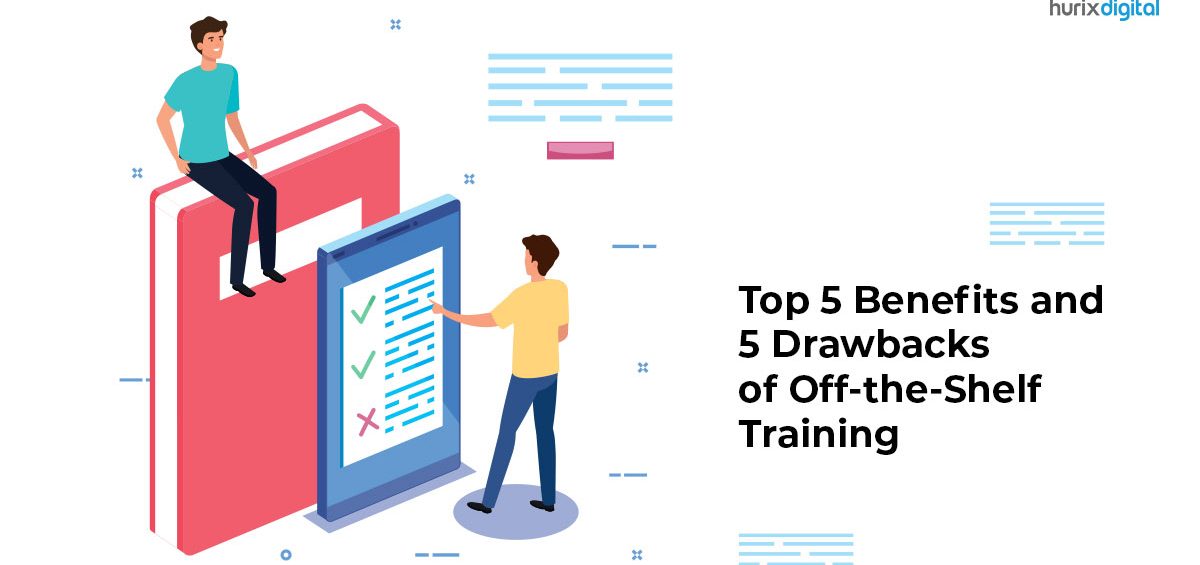Summary
This article provides a comprehensive overview of the advantages and disadvantages of custom corporate training solutions. It is essential for organizations to carefully evaluate the benefits and drawbacks of both custom and off the shelf training solutions to determine which is the best fit for their specific needs.
As a decision-maker striving to optimize your organization’s learning and development initiatives, you face the ever-present dilemma of choosing between off-the-shelf training materials and custom learning solutions. Both options offer distinct advantages and disadvantages of online learning, making it essential to carefully evaluate their suitability for specific training needs.
Custom learning content provides organizations with tailored programs, aligned precisely with their unique requirements, corporate culture, and processes. On the other hand, off-the-shelf eLearning modules are pre-built, covering various topics, ensuring cost and time savings. To make an informed decision, one must weigh the benefits and drawbacks of each approach to determine which best aligns with the organization’s goals and resources.
In this article, we explore off-the-shelf vs custom eLearning and provide you with a comprehensive understanding of how custom corporate training solutions can address the limitations of off-the-shelf alternatives.
Table of Contents:
- What are the Benefits of Off-The-Shelf eLearning?
- What are the Drawbacks of Off-The-Shelf eLearning?
- Conclusion
Benefits of Off-The-Shelf eLearning
1. Time and Cost-Effective
One of the primary advantages of off-the-shelf eLearning is the significant time and cost savings. Organizations do not have to invest in the extensive development process of custom eLearning. Instead, they can readily access pre-built modules aligning with their training objectives, thereby reducing overall development time and expenses.
2. Wide Variety of Topics
Off-the-shelf eLearning libraries often contain many topics and subjects. It allows organizations to choose from diverse training materials covering soft skills, compliance, technical training, and more. As a result, companies can cater to the specific needs of their employees without investing in specialized content development.
3. Quick Deployment
Ready-made eLearning modules can be quickly deployed to learners, facilitating rapid access to training materials. It is especially beneficial for time-sensitive or urgent training requirements, ensuring that employees can access the content when they need it the most.
4. Proven Content Quality
Reputable off-the-shelf eLearning providers typically offer high-quality content that has been thoroughly tested and evaluated. By choosing established eLearning companies with a track record of success, organizations can be confident that the training materials meet industry standards and deliver effective learning outcomes.
5. Standardized Content
Off-the-shelf eLearning companies often deploy large volumes of learning modules on various topics, in a very short time. It necessitates using standardized templates that facilitate superfast development and integration of the content. This approach ensures that the training materials are well-structured, standardized, and aligned with the learning objectives.
Also Read: Advantages of Custom Learning Content Over Off-the-Shelf Courses
Drawbacks of Off-The-Shelf eLearning
1. Lack of Personalization
Off-the-shelf eLearning content, by its very nature, is designed to cater to a broad audience. As a result, it may lack the personalization required to resonate with an organization’s unique culture, values, and specific learning needs. This cookie-cutter approach might lead to suboptimal engagement and reduced employee learning outcomes.
2. Limited Customization
Organizations often have specific training goals and objectives that require a high level of customization. Unfortunately, off-the-shelf eLearning solutions may not provide the flexibility to modify the content to fit these unique requirements. This lack of customization might hinder the ability to address organization-specific challenges effectively.
3. Outdated Content
As off-the-shelf eLearning modules serve multiple clients, they can become outdated or fail to keep up with rapidly evolving industries and best practices. When using such content, organizations risk providing employees with information that is no longer relevant or accurate.
4. Lack of Control Over Updates
When updates are required in off-the-shelf content, organizations are at the mercy of the content provider’s schedule. This lack of control over content updates might delay addressing critical changes or regulatory requirements.
5. Limited Interactivity and Engagement
Off-the-shelf eLearning modules often lack the interactivity and engagement that custom eLearning can offer. This limitation could result in a less immersive learning experience, potentially affecting knowledge retention and application.
Also Read: 7 Tips to Create Custom E-Learning Content on a Budget
Conclusion
Off-the-shelf eLearning presents an appealing option for organizations seeking quick and cost-effective training solutions. The convenience and accessibility of pre-built modules can significantly benefit organizations with limited resources and tight training schedules. However, it’s crucial to consider the drawbacks associated with limited customization and control over content updates.
To make an informed decision, organizations must weigh their specific training needs, budget constraints, and the level of customization required for an effective learning experience. In some cases, a combination of off-the-shelf and custom eLearning solutions might provide the ideal balance to cater to diverse training requirements in the corporate world.
If you need a partner to help you figure out the optimal blend of off-the-shelf and custom eLearning content for your needs, Hurix Digital is a fine choice. Write to us at marketing@hurix.com, and we will help you connect with domain experts.











